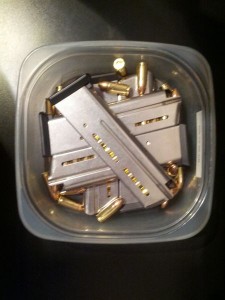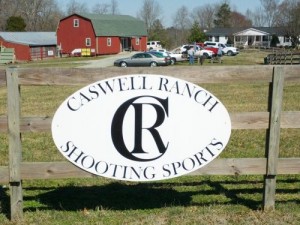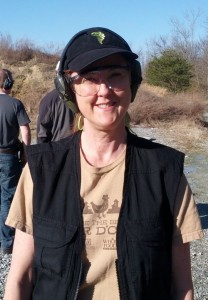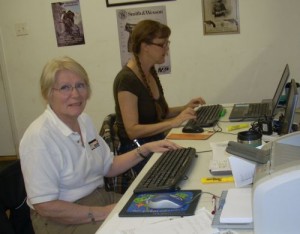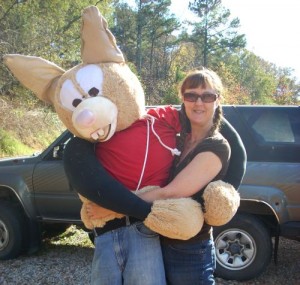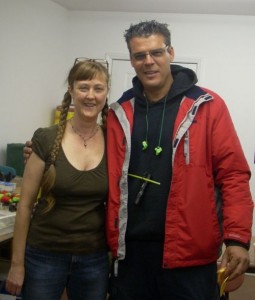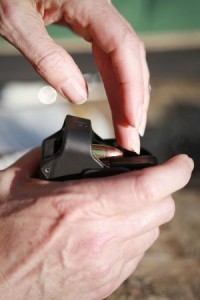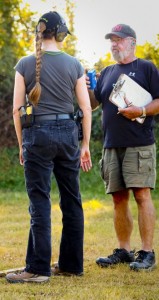In the previous post I shared my experience as a volunteer. But one post is just not enough.
I wanted to comment on the stages for the first and second match of the Triple Crown. I’m guessing I’d want to comment on the 3rd match too if I’d been there the 2nd day. I was dumbfounded at the creativity involved and wondered if this was typical of IDPA matches. Evidently not… One of the shooters shot the match and in his write up about the match he said:
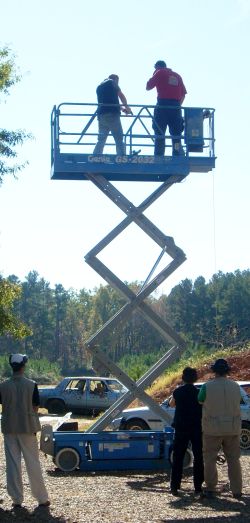
Shooting from the Scissors Lift
[Triple Crown, Day 1]
“Nearly every major match has 1 stage, feature, target,shooting position or something that is the signature of the match and shooters discuss whenever that match comes up. This match was a little different in that almost every stage would have been that signature at another match.”
“Toni Dandreamatteo and Frank Glover created a 2 day event that, without hyperbole, may never be done again, because this match was mentally and physically draining for every shooter, volunteer and the staff that put it on.” Posted by: Ron Larimer
Having never attended an outside match of any kind, I’ll take his word for it. The day stage that really intrigued me was the one that used the sissors lift. I love heights and had never thought about shooting down. I had the opportunity to go up on the lift once the shooting had stopped and see the angle into and behind the parked car below.

Target below the Scissors Lift
[Triple Crown, Day 1]
I also helped Toni clean up the lift before the rental company arrived to pick it up. It was 2 inches deep in brass at one spot. Toni extended the platform to get all the brass that had worked it’s way under the middle and was quick with the broom. Can you imagine the thoughts of the next rental customer if it had been just passed along? And I wonder how many shooters realize that the match director has many jobs, including one like this.
I helped set up several stages for the night match. I’d stand and hold targets while Toni directed, “back”, “left”, “not that far left”, etc. Each target was held in place by a metal spike to ensure that each squad through the stage shot the targets in the exact same placement. Targets were arranged to create challenging configurations when navigating a stage. He explained that advanced shooters would opt for the tougher shots and newer shooters could spend more time to move into a position to make the shot more clear. He reviewed options for holding a flashlight with me. Most important, he made me feel welcome and encouraged me to continue to grow my skills. But I digress…
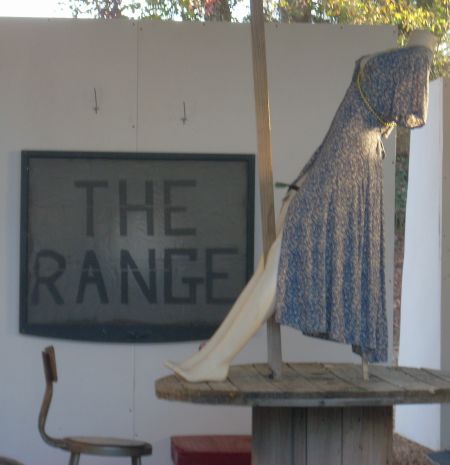
Welcome to the Strip Club! Shooters start seated with one hand on the dollar bill in her garter
Then there was the strip club. I think this was a “family” oriented strip club as the dress on that dancer was fairly modest.
However, the actions of the patrons in the private booths was a bit more risque. The “staff” was tagged as non-threats and I have to think the bad guys were a bit preoccupied. See photo below…

A patron in a private booth the IDPA Triple Crown “Strip Club” getting personal attention from a non-threat.
Toni told me the night match would include fire, water, and several flavors of light. I didn’t really understand what me meant till I attended the briefing.
Here’s the brief list of the night stages and what unique situation or challenge was included. I didn’t take the videos listed below, I found them with a quick search of YouTube.
1) The Water Stage included shooting out a window through a rain storm. The never ending storm was created via a fountain that was rigged just above the outside of the window. I heard one story when I was entering scores about a shooter who extended his gun into the “storm” and couldn’t figure out why it was steaming. The things you just don’t think about, eh? This stage also required a flashlight.
2) The “Police” Stage included a car with flashing orange and blue lights (think strobe).
3) The Strip Club used regular lighting and, in the process, worked against eyes that had become adjusted to the dark.
4) The “HeadLights” stage was triggered by a motion sensor and included shooting 3 steel plates across the bumper of a deliver truck (to stop the truck) and shooting a light bulb through a small hole in a steel plate that emulated a motorcycle headlight. [Video here].
5) The Deck stage was originally designed to be shot with an oil lantern as the only light. Guess what? The muzzle flash kept blowing out the lantern. This required a change in the stage requirements to switch to flashlights and the first group re-shot the stage after the change. I thought: better to figure this out in a match rather than in your own back yard with someone shooting back at you.
6) The Camp Fire stage was shot with light from the (electric) campfire only. Targets were very low to the ground to simulate a dog pack zeroing in on your campsite.
7) The Glock Convenience Store stage was shot using a large Mag Light provided at the stage. The entrance to the store was obscured by dangling firehose and would have been a challenge to shoot in daylight.

Frank briefing the “Car on Fire” stage
[Triple Crown Night Match]
8) The Car on Fire stage was the one that boggled my mind. Imagine sitting in the driver’s seat of a wrecked car with the engine on fire and having to defend yourself against a half a dozen freaks with guns. This stage simulated that experience. A flashlight was needed to pinpoint the furthest targets. [
Video here].
Shooting started at 6:30pm and the last set of scores came in around midnight. It was bitter cold and a big contrast to the 70 degree afternoon. These two matches made for a very long, very interesting day.
Attending as a volunteer still raised my awareness about shooting a match like one of these and prompted some questions:
- How do you layer to stay warm enough at night but not have your clothing get in the way of your holster and concealment garment?
- What’s the minimum amount of gear you need in your range bag as you have to haul it from stage to stage?
- How to you insure you don’t lose gear in the dark?
If this sounds like something you want the opportunity to shoot, there is another Day / Night / Day match next month: December 8 – 9 2012. Details are on the home page for
The Range.
Thanks to everyone who made me feel welcome. I have much to learn but this experience has made me eager to put the time in to improve my skills. Attend one match at The Range and you will never be a stranger again.

